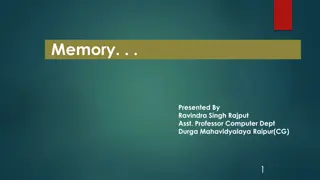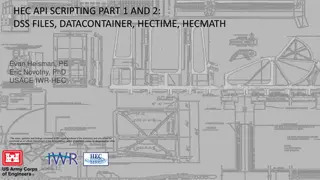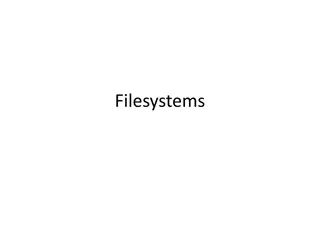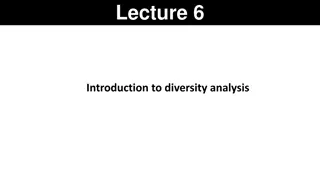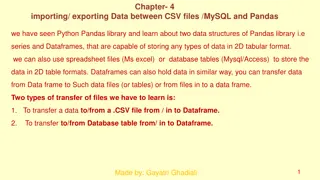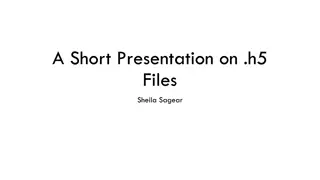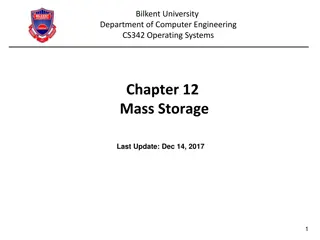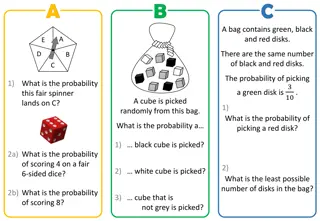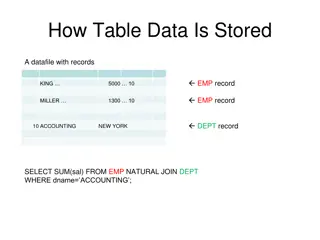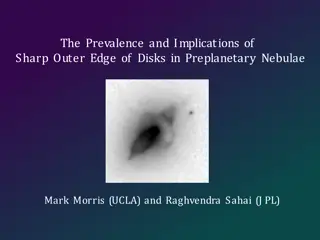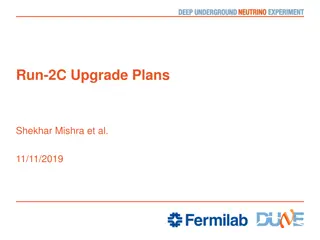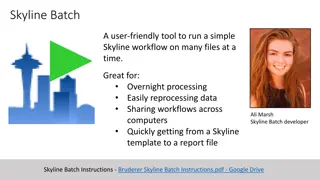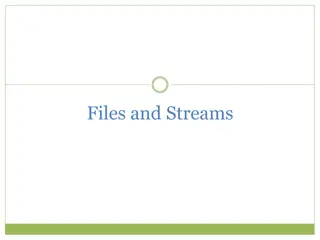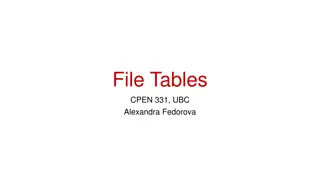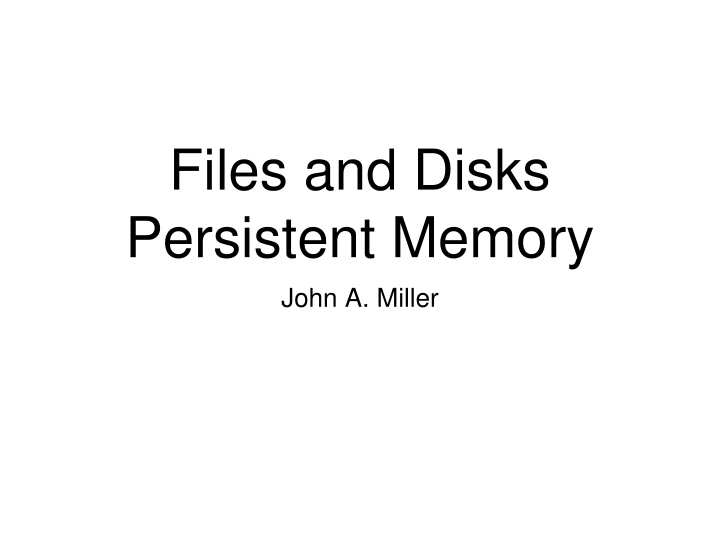
Types and Components of File Systems, Direct Access, and Disk Drive in Computers
Explore the concepts of file systems, direct access files, and disk drive components in computer systems. Learn about different types of files, disk memory organization, sequential and direct access methods, and the components of a disk drive like cylinders, surfaces, tracks, and sectors.
Download Presentation

Please find below an Image/Link to download the presentation.
The content on the website is provided AS IS for your information and personal use only. It may not be sold, licensed, or shared on other websites without obtaining consent from the author. If you encounter any issues during the download, it is possible that the publisher has removed the file from their server.
You are allowed to download the files provided on this website for personal or commercial use, subject to the condition that they are used lawfully. All files are the property of their respective owners.
The content on the website is provided AS IS for your information and personal use only. It may not be sold, licensed, or shared on other websites without obtaining consent from the author.
E N D
Presentation Transcript
Files and Disks Persistent Memory John A. Miller
Types of Files File = Collection of Blocks (4096 Bytes) containing Records (e.g., 200 bytes) Fixed Length vs. Variable Length Records Binary vs. Text File (typically encoded in ASCII or Unicode) Sequential vs. Direct Access (e.g., RandomAccessFile in Java) Spanning vs. Nonspanning (record may not cross a block boundary Contiguous vs. Noncontiguous Files
Direct Access Files Sequential Access: Open the file and read each record, one after the other Direct Access: Seek directly to the i-th record and read it, skipping prior records try { var raf = new RandomAccessFile ("/tmp/rad.dbf", "rw"); var recSize = 12; var record = new byte [recSize]; raf.write ("Record One ".getBytes ()); raf.write ("Record Two ".getBytes ()); raf.write ("Record Three".getBytes ()); raf.write ("Record Four ".getBytes ()); raf.seek (2 * recSize); var nBytes = raf.read (record, 0, recSize); out.println ("record = " + new String (record)); raf.close (); } catch (Exception ex) { } // try
Reading a Record Nonspanning Case Blocking factor bf = floor (sb/sr), e.g., floor (4096 / 200) = 20 records per block Seek to i-th record: in block j = floor (i/bf), e.g., i = 57 => j = 2), block 0, block 1, block 2 Transfer block 2 from disk into main memory cache Copy the 17-th record in block 2 from cache to user program File offest: 3400 bytes from start of block
Components of Disk Drive Cylinder - Region of Disk Drive accessible without moving the read/write head assembly Surface - Drive may have 1 to 4 disks, giving 2 to 8 recording surfaces (on top and bottom of each disk) Track - intersection of a cylinder and a surface or region accessible to one head without moving the read/write head assembly Sector - smallest addressable/transferrable component of a disk drive, several sectors per track, common sector size 512B Outer Tracks have move sectors than Inner Tracks
Time to Read a Record Assume time to copy record from main memory cache of user s program is negligible (main memory access time is in ns, while disk access time in ms) Time to Read a Block from a disk drive into main memory Tread = Tseek + Tlatency + Txfer = 5.041 ms Tseek = 3 ms - time to move read/write heads Tlatency = 2 ms - 15000 rpm => 250 rps => 4 ms rotation time (rotational latency is half that) Txfer = 4096 B / 100 MB/s = 0.041 ms where 100 MB/s is the average sustained transfer rate
Time to Read a Record Savio 15K Model Number ST973451SS ST936751SS Capacity Formatted 512 Kbytes/Sector (GB) 73.4 36.7 Interface 3-Gb/s SAS 3-Gb/s SAS External Transfer Rate (MB/s) 300 300 Performance Spindle Speed (RPM) 15K 15K Average Latency (ms) 2.0 2.0 Seek Time - Average Read/Write (ms) 2.9 / 3.3 2.9 / 3.3 - Track-to-Track Read/Write (ms) 0.2 / 0.4 0.2 / 0.4 Sustained Transfer Rate - Outer to Inner Diameter (MB/s) 112 to 79 112 to 79 Cache, Multisegmented (MB) 16 16 Configuration/Reliability Disks 2 1 Heads 4 2
SSD vs. HDD https://www.extremetech.com/extreme/210492-extremetech- explains-how-do-ssds-work
Time to Read a File Noncontiguous Case Let nr = 200,000 records, sr = 200 B, bf = floor (4096/200) = 20 nb = ceil (nr / bf) = ceil (200,000 / 20) = 10,000 blocks Total read time = 10,000 * 5.041 = 50,410 ms If the file content can be located in one cylinder and you have exclusive access to the disk drive, then seek times (the most costly of the three) can be eliminated
Execution Time for Point Queries select * from customer wherecname = John Doe cname = John Doe (customer) Determine number of block accesses nba for best, expected and worst cases Best: nba = 1 block accesses Worst: nba = nb = 10,000 block accesses Expected: nba = (nb + 1) / 2 = 5000.5 block accesses (derive this) Too slow: using Hashing and B+trees to speed up queries
Complexity of Linear Search: number of blocks nb = ceil (nr/bf) Linear Search Exact Asymptotic 1 O(1) Best (nb + 1) / 2 O(nb) Expected nb O(nb) Worst

